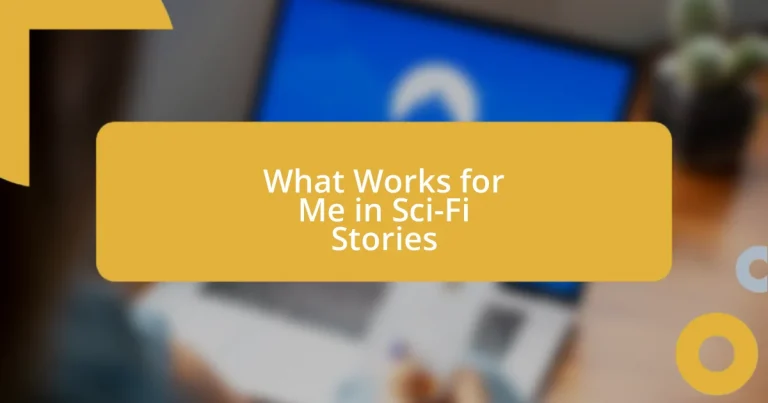Key takeaways:
- Great sci-fi stories blend intricate world-building, character development, and philosophical questions, creating immersive and thought-provoking narratives.
- Key elements of character development include backstory, complexity, evolution, relationships, and moral dilemmas, which enhance emotional engagement and relatability.
- Effective narrative structures, such as nonlinear storytelling and cliffhangers, along with clear stakes and unexpected twists, keep readers invested in the plot and characters’ journeys.

What defines great sci-fi stories
Great sci-fi stories often transport us to worlds that feel both foreign and familiar, striking a chord within our collective imagination. I remember reading “Dune” for the first time; the intricate world-building and political intrigue drew me in. Have you ever felt the pull of a universe so vividly crafted that you could almost picture yourself walking its landscapes?
Character development is another cornerstone of compelling sci-fi. It’s not just about advanced technology or alien creatures; it’s about the human experience. When I encountered the struggles of the crew in “The Martian,” I found myself rooting for them as if they were my friends facing insurmountable odds. These emotional connections make us invested in the story, don’t you think?
Additionally, great sci-fi poses intriguing philosophical questions that challenge our perceptions of reality. I often find myself contemplating the ethical dilemmas presented in stories like “Blade Runner.” They provoke thought and discussion about what it means to be human, leaving me pondering long after the last page. Isn’t that the true power of science fiction?

Key elements in character development
Character development in sci-fi isn’t just a subplot; it’s essential for breathing life into the narrative. I recall my first encounter with Han Solo in “Star Wars.” At first, he seemed like a typical rogue, but as his backstory unfolded, I began to empathize with his struggles and motivations. His growth from a self-serving smuggler to a hero reminded me of how deeply character arcs can resonate, grounding readers in the fantastical.
Here are some key elements that enhance character development in sci-fi stories:
- Backstory: Effective backstories provide context and depth, allowing readers to understand character motivations.
- Complexity: Characters with flaws and contradictions are more relatable, mirroring the complexities of real life.
- Evolution: Watching a character grow or change in response to their challenges provides a sense of realism and investment in their journey.
- Relationships: Interpersonal dynamics can highlight character traits and help propel the story forward.
- Moral Dilemmas: Encountering ethical challenges forces characters (and readers) to confront their beliefs, enhancing emotional engagement.
These elements not only cultivate memorable characters but also elevate the narrative, making it more than just a tale about spaceships and aliens. They invite us into a deeper exploration of identity, making every character feel like someone we know, or perhaps even aspire to be.
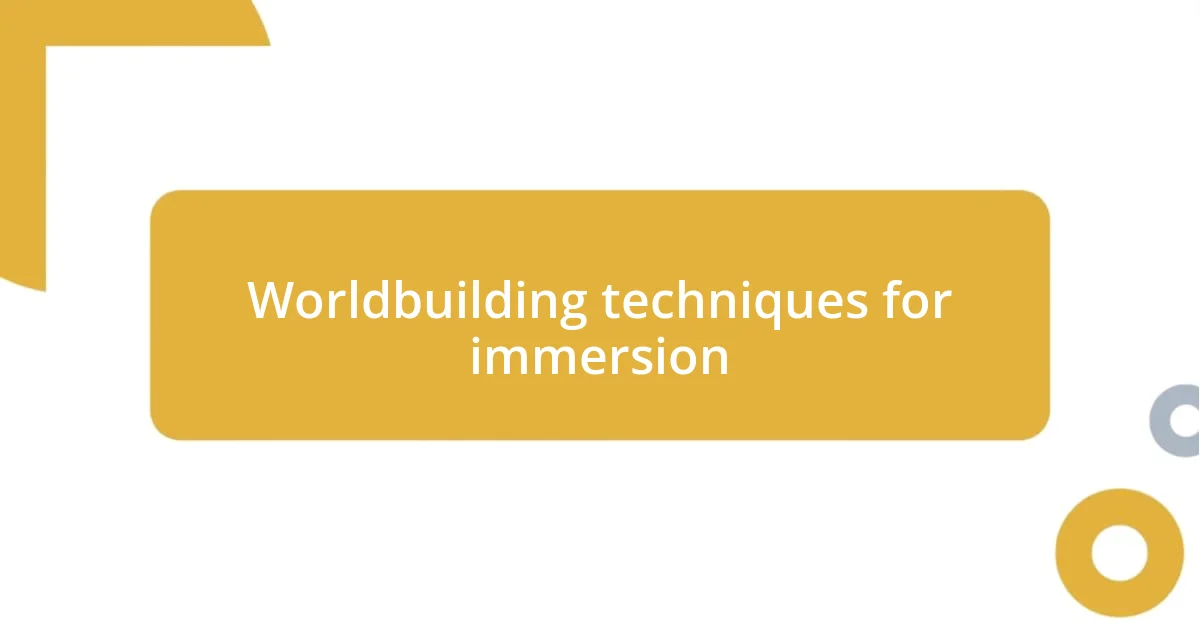
Worldbuilding techniques for immersion
Worldbuilding techniques play a pivotal role in creating immersive sci-fi stories. One technique I’ve found particularly effective is the use of sensory details. For instance, when reading “Neuromancer,” I vividly remember the gritty texture of the city streets and the sharp, electric smell of the technology that permeated every corner. By engaging multiple senses, a world transforms from mere words into a palpable experience. Have you ever found yourself lost in a book where you could “feel” the world around the characters?
Another key technique I’ve noticed is the consistency of the rules governing the world. When a sci-fi story follows its own internal logic, it allows me to suspend disbelief and be fully engaged. “Foundation” does this beautifully, establishing complex societal structures and technologies that make sense within its universe. This coherence invites me to explore the narrative deeply, as I feel grounded in a reality that, while far-fetched, adheres to its own principles. It’s like being invited into a friend’s elaborate dream, filled with rules that, once understood, make the experience all the more captivating.
Finally, including folklore or myth within the world can enhance immersion. When I read stories with origin myths or cultural rituals, like in “The Left Hand of Darkness,” I feel a connection to the characters that transcends the pages. Those aspects enrich the narrative landscape, making me curious about the history and traditions that shape the characters’ lives. How often do you find yourself wanting to learn more about the worlds that have been meticulously built around the stories you love?
| Technique | Description |
|---|---|
| Sensory Details | Engaging multiple senses enhances immersion and makes worlds feel real. |
| Consistency of Rules | A well-defined internal logic allows for suspension of disbelief and deeper engagement. |
| Folklore and Myth | Incorporating cultural elements adds depth and a sense of connection to the characters. |
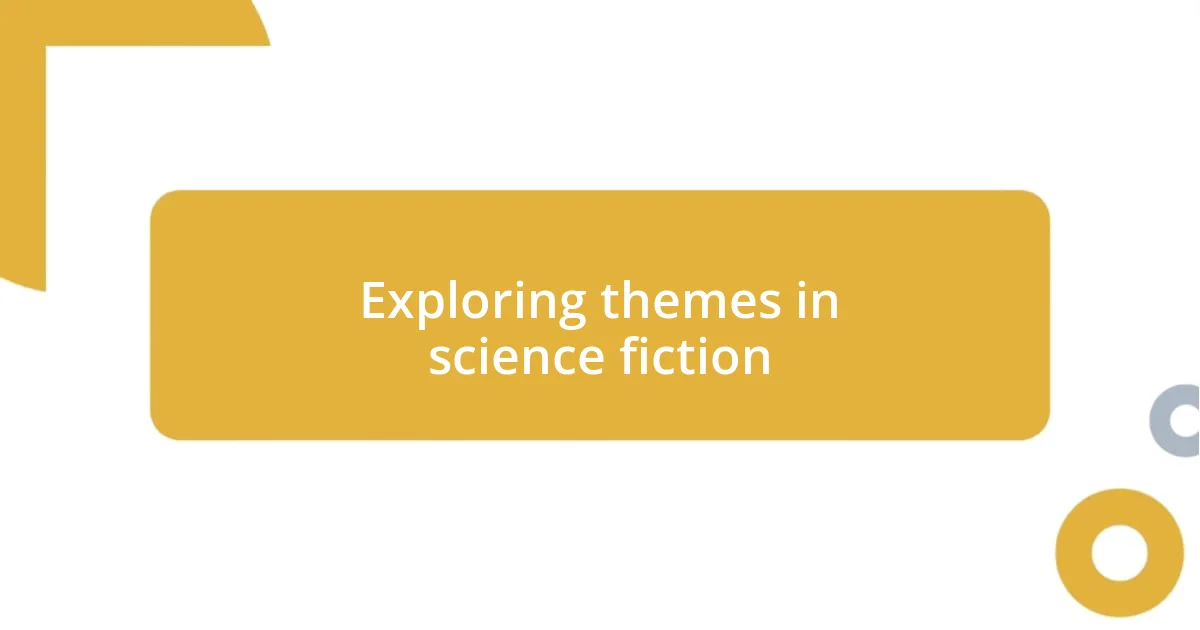
Exploring themes in science fiction
Exploring themes in science fiction can be a deeply enriching experience for both the reader and the writer. A theme I often find compelling is the exploration of identity, particularly in stories that delve into what it means to be human. When I read “Do Androids Dream of Electric Sheep?” I was struck by the profound questions it raises about consciousness and empathy. These themes resonate so much with the human experience, don’t they? They remind us that our identities can be fluid and shaped by our choices and circumstances, whether we’re human or not.
Another theme that captivates me is the relationship between technology and society. I can’t help but reflect on my own interactions with technology and how they shape my daily life. In “Black Mirror,” for example, I found myself grappling with the implications of virtual reality and social media. It’s fascinating and somewhat unsettling to see projections of our world’s future that mirror our present anxieties. How do you feel about the way technology influences your relationships? I often ponder this as I strive to balance the benefits of technology with its potential downsides.
Then there’s the theme of societal change, which often goes hand-in-hand with a dystopian backdrop. Works like “The Handmaid’s Tale” force me to confront uncomfortable truths about politics and gender roles. The emotional weight of such narratives stays with me long after I’ve closed the book. It seems that sci-fi can serve as a mirror of our current society, allowing us to confront our fears and aspirations about the future. Have you ever found yourself reflecting on your world after reading a sci-fi story? That’s the power of these themes; they act as catalysts for introspection and conversation, making sci-fi not just a genre but a profound exploration of humanity itself.
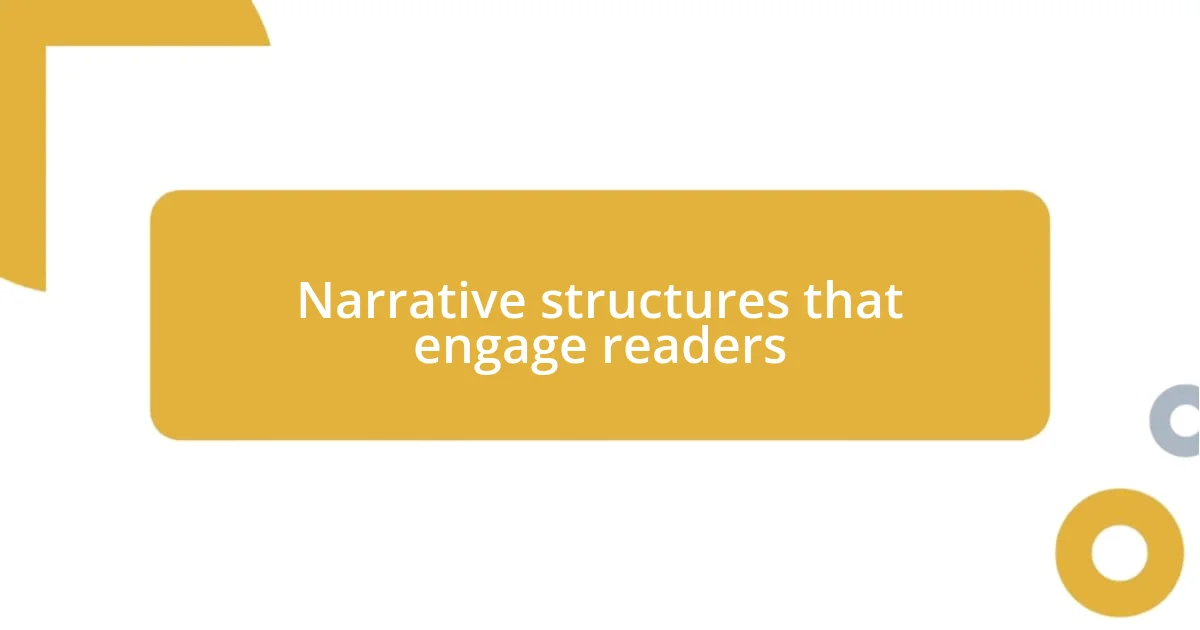
Narrative structures that engage readers
When considering narrative structures that truly engage readers, I’ve often found that nonlinear storytelling can create a captivating experience. Take “Cloud Atlas,” for instance. The way it weaves together multiple timelines and perspectives keeps me on my toes, creating a sense of intrigue that pulls me deeper into the world. It’s like piecing together a beautiful puzzle—each fragment adds richness to the overall picture. Don’t you just love that feeling of discovery as you realize how stories are interconnected?
I’ve also noticed that cliffhanger endings can be incredibly effective in driving engagement. I remember finishing “The Expanse” series, and oh, how I was left reeling! Each installment ended with a tantalizing twist or revelation that made the wait for the next book feel like an eternity. This structure not only keeps the reader invested but also sparks endless discussions and theories among fans. Have you ever found yourself eagerly anticipating what comes next because of a perfectly timed cliffhanger?
Moreover, the use of multiple viewpoints can pack an emotional punch. In “The Fifth Season,” the varying perspectives give depth to the narrative, allowing me to connect with different characters on multiple levels. It’s fascinating how seeing a world through diverse lenses can challenge my assumptions and evoke empathy. I often wonder: how does experiencing a story from different angles change your understanding of it? That layering of viewpoints enriches not just the narrative but the reader’s emotional journey, making for a truly transformative experience.

Tips for writing compelling plots
When it comes to crafting a compelling plot, I believe establishing clear stakes is essential. A story thrives on tension, and I’ve found that when characters face tangible consequences for their actions, the narrative naturally gains momentum. For instance, in my experience reading “The Hunger Games,” the constant threat of danger kept me glued to each page, making me care about Katniss like she was a friend fighting for survival. Don’t you feel that way when you’re deeply invested in a character’s journey?
Another tip is to create unexpected twists that challenge reader expectations. I vividly remember the moment in “The Left Hand of Darkness” when the true nature of gender is revealed. It took me by surprise and reshaped my understanding of the world within the story. I find that effective plot twists can not only propel the story forward but also prompt deeper reflection on the themes at play. What if you could surprise your readers with a twist that changes everything they thought they knew?
Finally, I often emphasize the importance of character development throughout the plot. In “Ender’s Game,” Ender Wiggin’s evolution from a reluctant boy to a strategic leader is incredibly powerful. His internal struggles resonate with the reader, making every high-stakes decision he faces feel meaningful. I wonder, how do you feel when a character’s growth mirrors your own experiences? By ensuring that characters grow and change, the plot becomes a vivid exploration of their inner worlds, enhancing emotional investment in the journey.
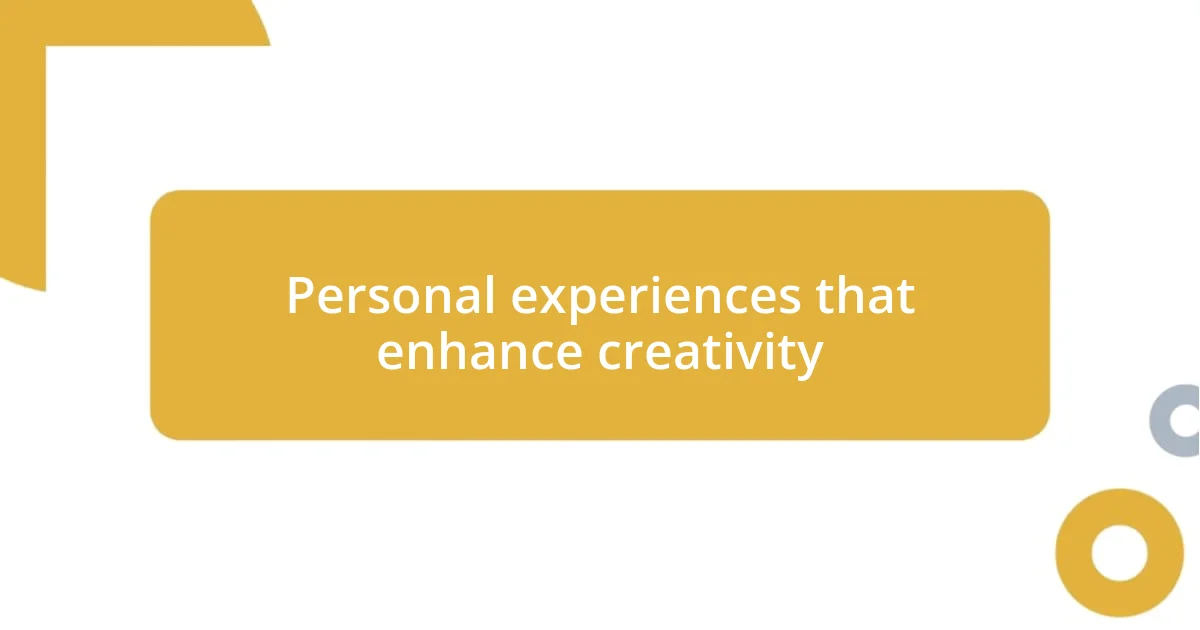
Personal experiences that enhance creativity
I’ve found that immersing myself in different environments can work wonders for my creativity. For example, a cozy coffee shop filled with the smell of roasted beans often sparks new ideas, allowing my mind to wander freely while I observe the ebb and flow of life around me. Have you ever noticed how a change in scenery can refresh your perspective? I truly believe the ambiance can inspire unique plotlines or characters just waiting to be discovered.
Another experience that enhances my creativity is engaging with diverse forms of art. Recently, I visited an exhibition that featured surrealistic paintings, and it left me buzzing with ideas. Each piece told a story that challenged my perception of reality and made me wonder: how can I incorporate such imaginative concepts into my own narratives? Those moments of artistic awe often translate into bursts of inspiration that shape my writing.
Lastly, reflecting on my own experiences can be a profound source of creativity. I often draw from my emotions and life lessons, like the time I faced a significant setback and had to re-evaluate my direction. This introspection allows me to create characters who are raw and relatable, struggling with their own challenges. Don’t you think that weaving personal truth into fiction can lead to deeper connections with readers? When I channel my experiences into storytelling, it transforms the narrative into something more authentic and resonant.











